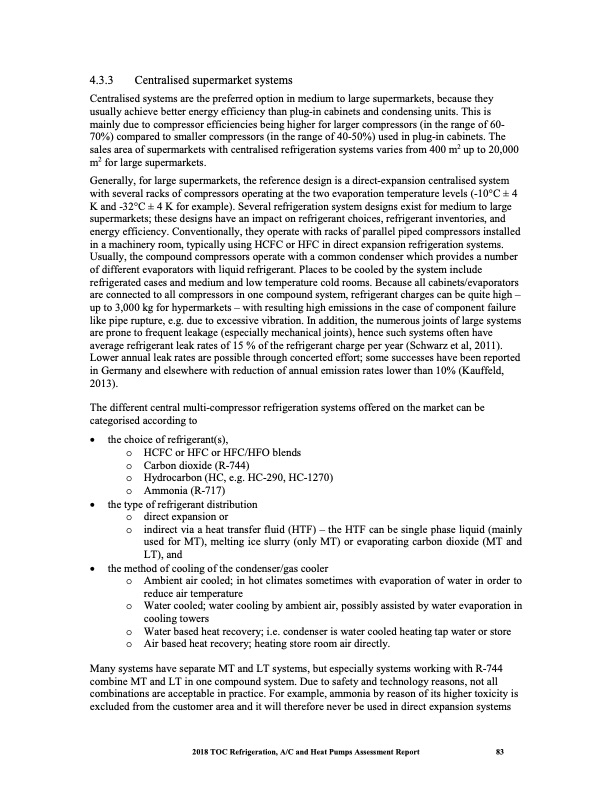
PDF Publication Title:
Text from PDF Page: 096
4.3.3 Centralised supermarket systems Centralised systems are the preferred option in medium to large supermarkets, because they usually achieve better energy efficiency than plug-in cabinets and condensing units. This is mainly due to compressor efficiencies being higher for larger compressors (in the range of 60- 70%) compared to smaller compressors (in the range of 40-50%) used in plug-in cabinets. The sales area of supermarkets with centralised refrigeration systems varies from 400 m2 up to 20,000 m2 for large supermarkets. Generally, for large supermarkets, the reference design is a direct-expansion centralised system with several racks of compressors operating at the two evaporation temperature levels (-10°C ± 4 K and -32°C ± 4 K for example). Several refrigeration system designs exist for medium to large supermarkets; these designs have an impact on refrigerant choices, refrigerant inventories, and energy efficiency. Conventionally, they operate with racks of parallel piped compressors installed in a machinery room, typically using HCFC or HFC in direct expansion refrigeration systems. Usually, the compound compressors operate with a common condenser which provides a number of different evaporators with liquid refrigerant. Places to be cooled by the system include refrigerated cases and medium and low temperature cold rooms. Because all cabinets/evaporators are connected to all compressors in one compound system, refrigerant charges can be quite high – up to 3,000 kg for hypermarkets – with resulting high emissions in the case of component failure like pipe rupture, e.g. due to excessive vibration. In addition, the numerous joints of large systems are prone to frequent leakage (especially mechanical joints), hence such systems often have average refrigerant leak rates of 15 % of the refrigerant charge per year (Schwarz et al, 2011). Lower annual leak rates are possible through concerted effort; some successes have been reported in Germany and elsewhere with reduction of annual emission rates lower than 10% (Kauffeld, 2013). The different central multi-compressor refrigeration systems offered on the market can be categorised according to • the choice of refrigerant(s), o HCFCorHFCorHFC/HFOblends o Carbondioxide(R-744) o Hydrocarbon (HC, e.g. HC-290, HC-1270) o Ammonia(R-717) • the type of refrigerant distribution o directexpansionor o indirect via a heat transfer fluid (HTF) – the HTF can be single phase liquid (mainly used for MT), melting ice slurry (only MT) or evaporating carbon dioxide (MT and LT), and • the method of cooling of the condenser/gas cooler o Ambient air cooled; in hot climates sometimes with evaporation of water in order to reduce air temperature o Water cooled; water cooling by ambient air, possibly assisted by water evaporation in cooling towers o Waterbasedheatrecovery;i.e.condenseriswatercooledheatingtapwaterorstore o Airbasedheatrecovery;heatingstoreroomairdirectly. Many systems have separate MT and LT systems, but especially systems working with R-744 combine MT and LT in one compound system. Due to safety and technology reasons, not all combinations are acceptable in practice. For example, ammonia by reason of its higher toxicity is excluded from the customer area and it will therefore never be used in direct expansion systems 2018 TOC Refrigeration, A/C and Heat Pumps Assessment Report 83PDF Image | Heat Pumps Technical Options

PDF Search Title:
Heat Pumps Technical OptionsOriginal File Name Searched:
RTOC-assessment-report-2018_0.pdfDIY PDF Search: Google It | Yahoo | Bing
CO2 Organic Rankine Cycle Experimenter Platform The supercritical CO2 phase change system is both a heat pump and organic rankine cycle which can be used for those purposes and as a supercritical extractor for advanced subcritical and supercritical extraction technology. Uses include producing nanoparticles, precious metal CO2 extraction, lithium battery recycling, and other applications... More Info
Heat Pumps CO2 ORC Heat Pump System Platform More Info
| CONTACT TEL: 608-238-6001 Email: greg@infinityturbine.com | RSS | AMP |